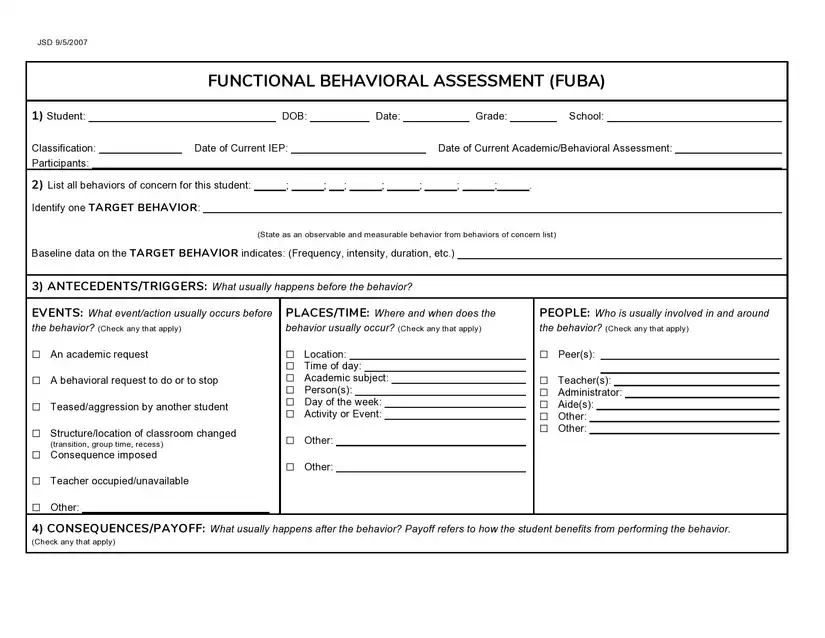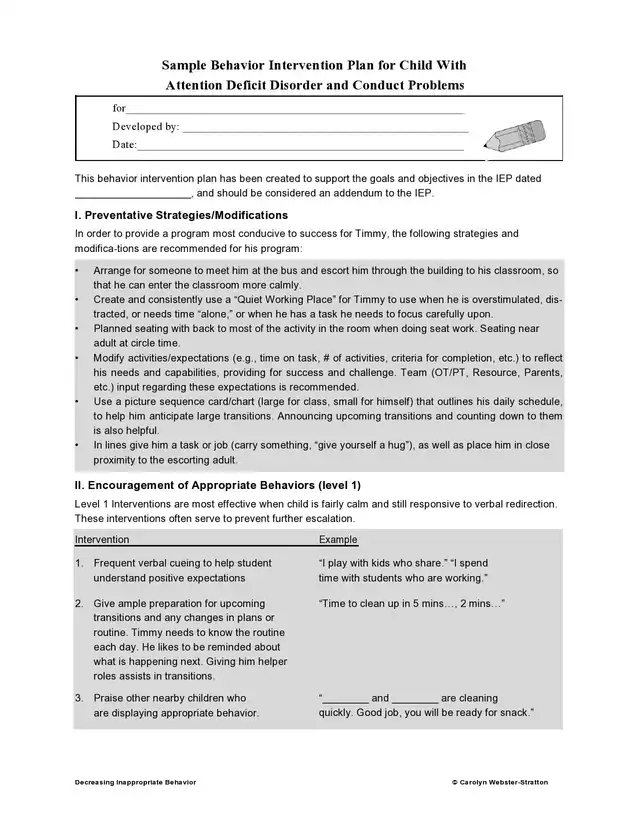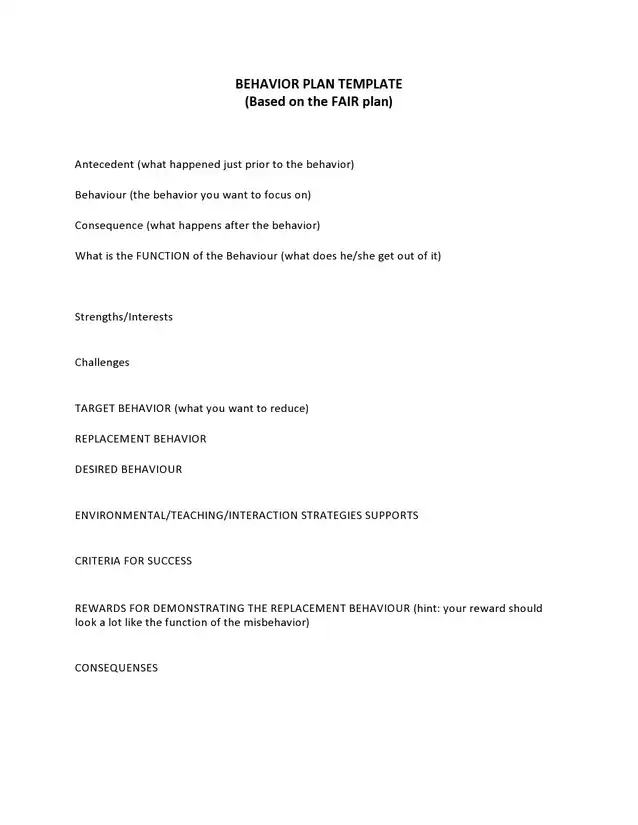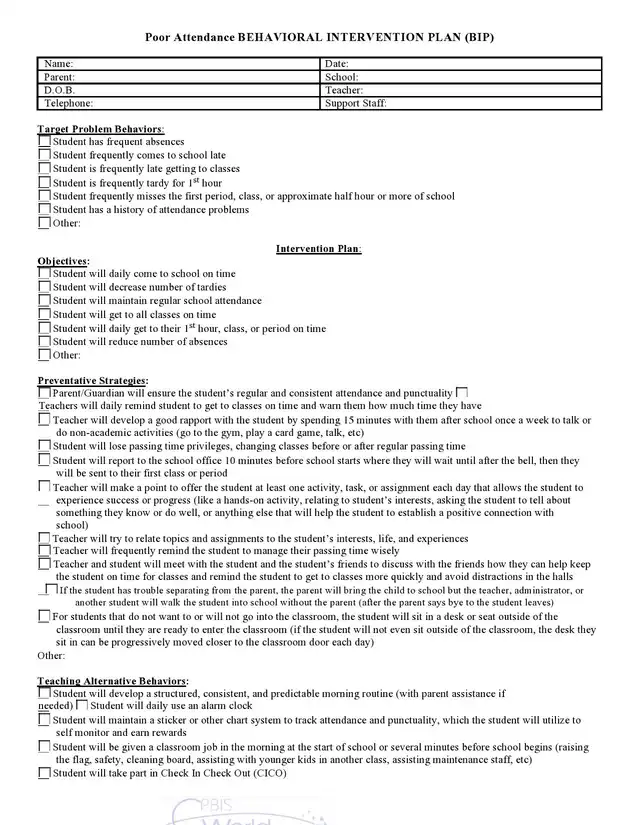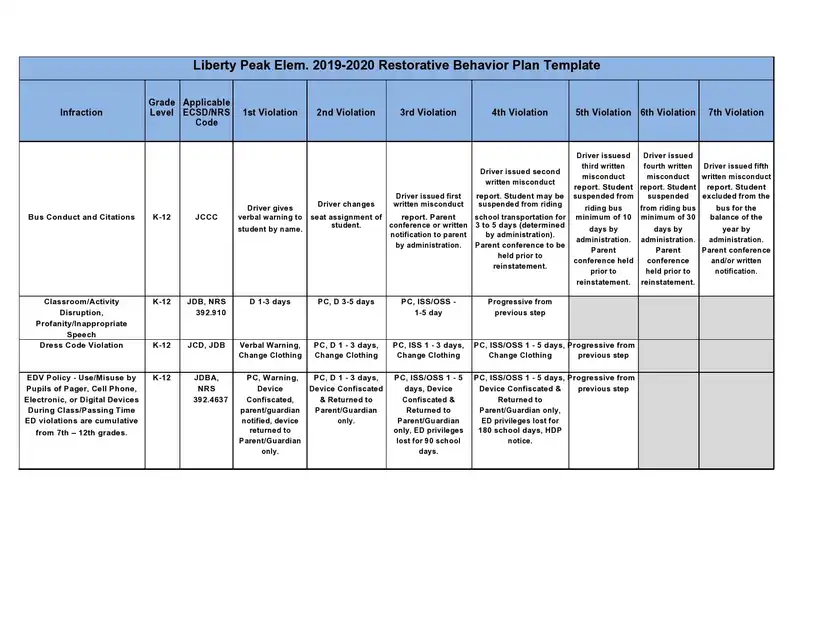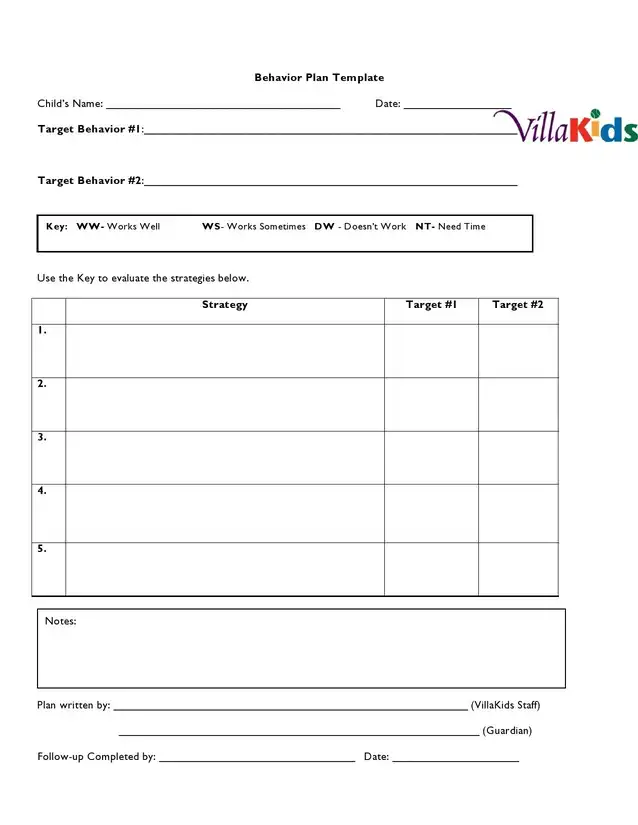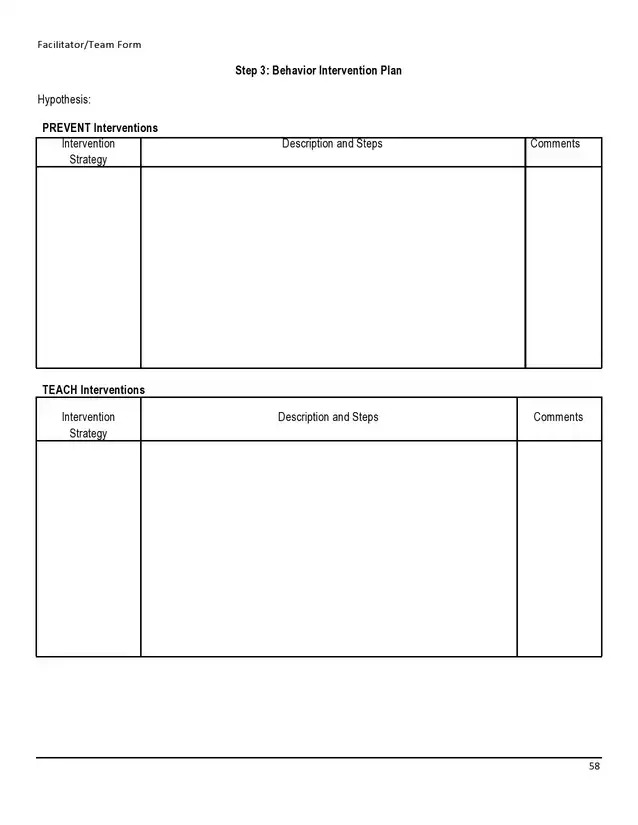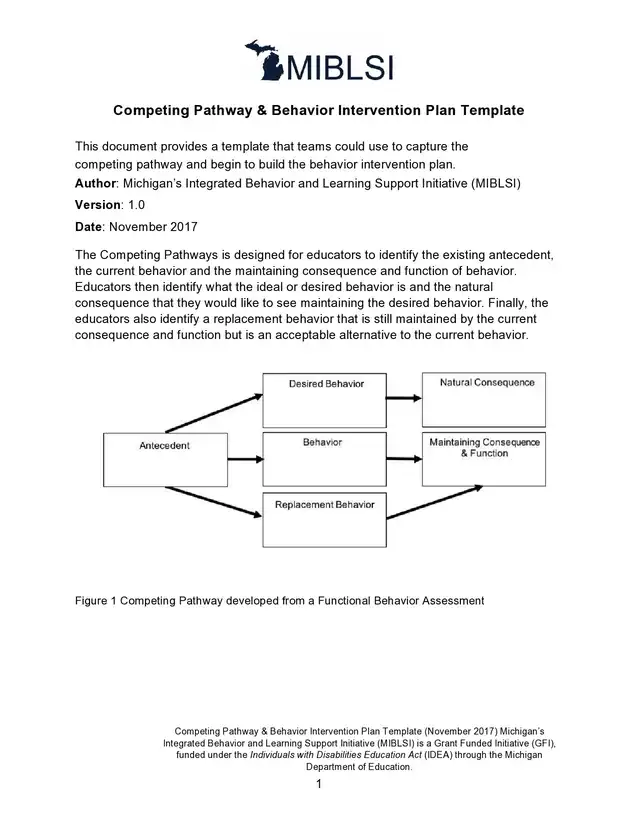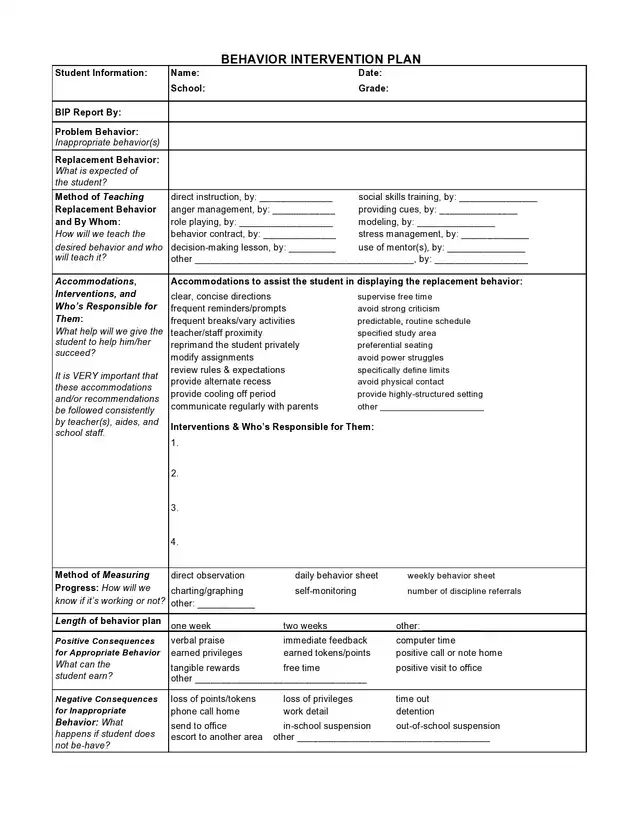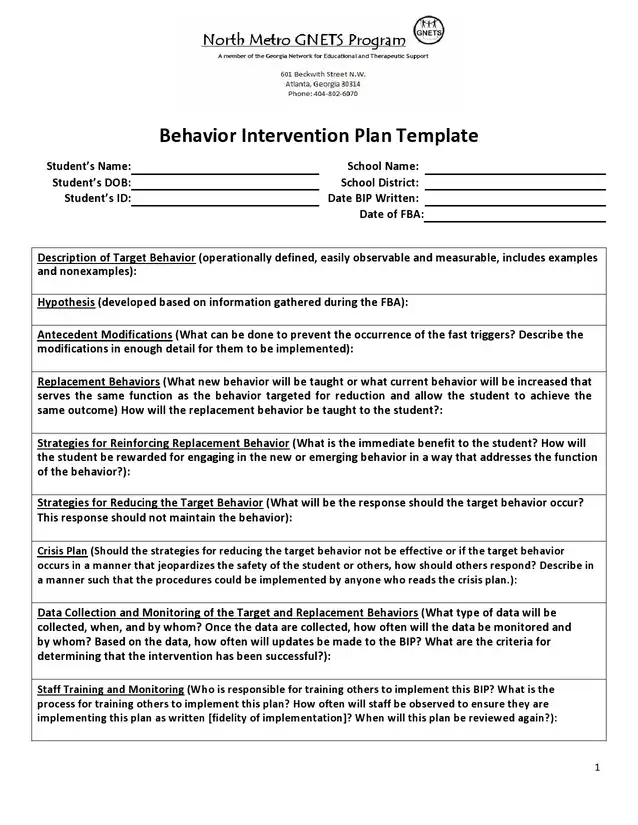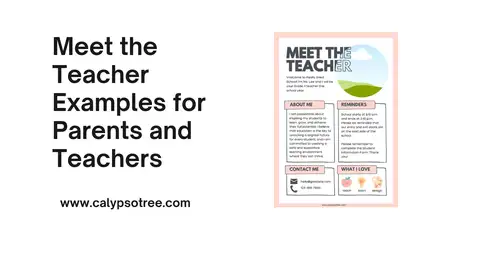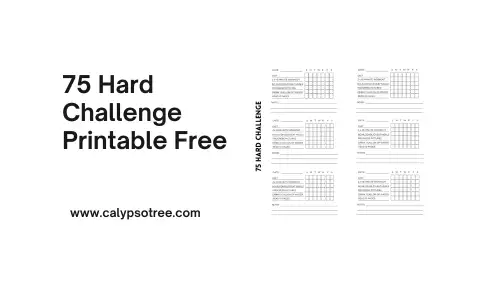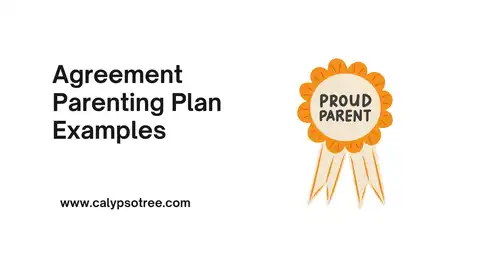A Behavior Intervention Plan (BIP) is a plan used in schools and therapy to help kids change difficult behaviors. The main goal of a BIP is to turn negative behaviors into positive ones. In this guide, we will explain what a BIP is, how to make one, and give some examples. This will help teachers, parents, and therapists use this tool to support kids better.
What is a Behavior Intervention Plan?
A BIP is a step-by-step guide that helps change problem behaviors. It’s used for students who might have trouble in class because of how they act. A BIP shows what to do to help these students learn better ways to behave.
A BIP is made after a Functional Behavior Assessment (FBA). This assessment helps find out why a child is behaving a certain way. It looks at what makes the behavior happen and what keeps it going. This information helps make a plan to change the behavior.
Key Components of a BIP
Student Information
Basic details about the student, including their strengths, interests, and specific areas of concern.
Target Behaviors
Clearly defined behaviors that need to be changed. These should be specific, observable, and measurable.
Function of Behavior
Understanding the ‘why’ behind the behavior. Common functions include gaining attention, avoiding tasks, or seeking sensory input.
Intervention Strategies
- Preventive Strategies: Steps to prevent the behavior from occurring.
- Teaching Strategies: Skills or behaviors that the student will be taught to replace the problematic ones.
- Response Strategies: How adults will respond when the behavior occurs, including both positive reinforcement for desired behaviors and consequences for inappropriate ones.
Data Collection
Methods for tracking the behavior over time to assess the effectiveness of the intervention.
Review Schedule
A timeline for reviewing the plan’s effectiveness and making adjustments as needed.
Who Can Create a Behavior Intervention Plan?
Here’s who can help make a BIP:
- Teachers: Teachers see the child every day in school. They know how the child behaves in class and can help decide what needs to change.
- Parents and Guardians: Parents know their child very well. They can share what they see at home and help make sure the plan works there too.
- School Counselors: Counselors talk to students about their feelings. They can help understand why a child is acting out and how to help them.
- School Psychologists: Psychologists study behavior and learning. They can do tests to learn why a child behaves a certain way and suggest ways to help.
- Behavior Specialists: These experts know a lot about changing behavior. They can work with teachers and parents to make the BIP.
- Therapists: If a child sees a therapist, the therapist can also help create a plan to use both at home and in school.
- The Student: Sometimes, it’s good to ask the child about the plan. They can share what they think might help them behave better.
By working together, everyone can make a good plan to help the child behave better both at school and at home.
When Should a Behavior Intervention Plan Be Used?
Here are some times when a BIP might be needed:
- Disruptive Behavior: If a child is often interrupting the class, being loud, or not following rules, a BIP can help.
- Trouble Making Friends: If a child has a hard time sharing, taking turns, or being kind to others, a BIP can teach them better ways to act.
- Not Doing Work: If a child refuses to do their schoolwork or tries to avoid it, a BIP can find out why and help them focus better.
- Unsafe Actions: If a child is doing things that might hurt themselves or others, like hitting or throwing things, a BIP can help keep everyone safe.
- Ongoing Problems: If a behavior problem has been going on for a long time and hasn’t gotten better with simple rules, a BIP might be needed.
- Big Emotions: If a child has a lot of meltdowns or gets very upset often, a BIP can help them learn to stay calm.
- Special Needs: If a child has special needs and behavior problems, a BIP can be part of their special help plan at school.
- After a Behavior Check: If teachers or parents have looked closely at why a child is acting a certain way, a BIP can be made to help fix the problem.
Using a BIP in these situations can help children learn better behaviors, feel safer, and do better in school.
Example of a Behavior Intervention Plan
Student Information:
- Name: Alex
- Age: 8
- Grade: 3rd
- Strengths: Excellent at math, enjoys drawing, friendly with peers
Target Behavior:
- Talking out of turn during class instructions.
Function of Behavior:
- To gain attention from peers and adults.
Intervention Strategies:
- Preventive Strategies:
- Teacher will provide clear expectations for classroom behavior at the start of each lesson.
- Alex will be given a visual cue card on his desk as a reminder to raise his hand before speaking.
- Teaching Strategies:
- Alex will be taught to use a “think first” strategy before speaking.
- Role-playing sessions will be conducted to practice raising his hand and waiting to be called on.
- Response Strategies:
- When Alex raises his hand and waits, he will receive verbal praise or a small reward.
- If Alex speaks out of turn, he will be reminded to use his cue card and then will be asked to wait until it’s his turn to speak.
Data Collection:
- The teacher will use a behavior chart to track the number of times Alex talks out of turn and the number of times he raises his hand correctly.
Review Schedule:
- The plan will be reviewed every two weeks to assess progress and make any necessary adjustments.
Behavior Intervention Plan PDF
Why Use a Behavior Intervention Plan?
Here are some simple reasons why a BIP is important:
- Helps Kids Learn: When kids behave well, they can pay better attention to their schoolwork. A BIP helps them learn how to act in a way that makes learning easier.
- Teaches Good Habits: A BIP helps kids learn what they should do instead of what they shouldn’t do. For example, if a child usually interrupts, the BIP might teach them to raise their hand instead.
- Stops Bad Behaviors: By understanding why a child is acting out, adults can find ways to stop these behaviors. This helps create a calm and safe place for everyone.
- Makes Kids Feel Good: When kids behave well, they often get praise or rewards. This makes them feel proud and happy about what they are doing.
- Keeps Everyone Safe: Some behaviors might hurt the child or others. A BIP helps keep everyone safe by addressing these behaviors early on.
- Works as a Team: A BIP often involves many people, like teachers, parents, and sometimes the kids. Working together helps everyone understand how to support the child.
- Helps Kids Become Independent: Over time, kids learn to manage their own behavior. This makes them more independent and responsible as they grow up.
Steps to Develop a Behavior Intervention Plan
Conduct a Functional Behavior Assessment (FBA):
Gather data through observations, interviews, and questionnaires to understand the function of the behavior.
Define Target Behaviors:
Clearly specify what behaviors need to be addressed.
Develop Intervention Strategies:
Create strategies tailored to the student’s needs, considering their strengths and interests.
Implement the Plan:
Put the strategies into action consistently across all settings where the behavior occurs.
Monitor and Evaluate:
Collect data on the behavior and review it regularly to determine the plan’s effectiveness and make adjustments as needed.
Best Practices for Creating an Effective Behavior Intervention Plan
Here are some easy tips to make sure your BIP works well:
- Work Together: It’s important to include everyone who works with the child. This means teachers, parents, and sometimes even the child. When everyone helps to make the plan, it becomes stronger and more effective.
- Be Clear and Simple: The BIP should be easy to understand. Make sure the goals are clear, like “raise your hand before speaking” or “stay in your seat during lessons.” This way, everyone knows exactly what is expected.
- Focus on the Positive: Instead of only telling kids what not to do, the plan should teach them what they should do. Praise and rewards for good behavior can help kids feel good about themselves and encourage them to keep trying.
- Keep Track of Progress: Use simple charts or stickers to track how often the good behavior happens. This helps everyone see what’s working and what might need to change.
- Stay Consistent: It’s important that everyone follows the BIP the same way. This means teachers, parents, and anyone else working with the child should respond the same way to behaviors. Consistency helps the child learn faster.
- Review and Adjust: Regularly look at how the plan is working. If things are going well, keep going! If not, make small changes to help the child succeed. Remember, every child is different, so be ready to adjust the plan as needed.
- Include Fun Rewards: Adding small rewards or fun activities when the child shows good behavior can make the BIP more exciting. Rewards can be things like extra playtime, stickers, or a special treat.
- Be Patient: Changing behavior takes time. Be patient with the child and yourself. Celebrate small steps in the right direction, and remember that every bit of progress is a success.
- Use Visual Aids: Sometimes, pictures or charts can help kids understand what they need to do. Visual aids are great for younger children or those who need extra help understanding instructions.
- Encourage Self-Reflection: As kids grow, help them think about their own behavior. Ask them how they feel about their actions and what they could do differently next time. This helps them learn to control their own behavior over time.
Challenges in Implementing a Behavior Intervention Plan
Here are some problems that might come up and how to solve them:
Not Enough Help: Sometimes, schools don’t have enough staff or tools to help with the BIP.
Solution: Schools can ask parents to help at home and train more staff to support the plan.
Inconsistent Follow-Through: If not everyone follows the BIP, it can confuse the child and make the plan less effective.
Solution: All teachers and parents should understand the BIP and stick to it. Regular meetings can help make sure everyone is on the same page.
Kids Don’t Want to Change: Some kids might not like the new rules or changes and may resist them.
Solution: Make the plan fun and rewarding. Giving praise and little rewards can encourage kids to follow the new rules.
Lack of Training: If teachers or parents don’t know how to use the BIP properly, it might not work well.
Solution: Schools should provide training to all staff and parents involved. This training should show them how to use the BIP and track progress.
Poor Communication: If there isn’t good communication between teachers, parents, and others, the BIP might not be followed correctly.
Solution: Regular updates and open communication are important. Parents and teachers should talk often about how the child is doing with the BIP.
Behavior is Hard to Change: Sometimes, a behavior has been happening for a long time and is tough to change.
Solution: Be patient and break the behavior change into small steps. Celebrate each small success to keep the child motivated.
Different Settings: Kids may act differently at school and at home, making it hard to follow the BIP everywhere.
Solution: Parents and teachers should work together to use the BIP in all settings. This helps the child learn that good behavior is important everywhere.
Strong Emotions: Some kids may have big feelings about the changes in the BIP. They might feel frustrated or upset.
Solution: It’s important to talk to the child about their feelings and explain why the changes are good for them.
Behavior Doesn’t Change Everywhere: Kids might show good behavior in one place but not in another.
Solution: Practice the good behavior in different places with different people. This helps kids learn to behave well everywhere.
Getting Tired of the Plan: Over time, kids, parents, and teachers might get tired of the BIP, especially if changes happen slowly.
Solution: Keep the plan interesting by celebrating small victories. Regularly update the plan to keep it fresh and engaging.
Strategies for Overcoming Challenges
Here are some simple strategies to overcome common challenges:
- Not Enough Help: If there aren’t enough teachers or resources to support the BIP, ask for help from parents and volunteers. Schools can also train more staff to help with the plan.
- Inconsistent Follow-Through: Make sure everyone knows how to follow the BIP. Hold regular meetings or send reminders to keep everyone on track.
- Kids Don’t Want to Change: If a child is having a hard time with the BIP, try to make it more fun. Use lots of praise, rewards, and encouragement to help them stay motivated.
- Lack of Training: Provide training sessions for teachers and parents. Make sure they know how to use the BIP and what to do if they need help.
- Poor Communication: Keep the lines of communication open. Use notes, emails, or meetings to keep parents and teachers informed about how the child is doing.
- Behavior is Hard to Change: Be patient and break down goals into smaller steps. Celebrate each little success and keep encouraging the child.
- Different Settings: Kids might behave differently at home than they do at school. Work with parents to use the BIP in all settings.
- Strong Emotions: If a child feels upset or frustrated with the BIP, talk to them about their feelings. Help them understand why the plan is important and how it helps them.
- Behavior Doesn’t Change Everywhere: Practice good behavior in different places and with different people.
- Getting Tired of the Plan: To keep things fresh, update the plan regularly. Add new rewards or change activities to keep the child interested.
Case Study: Successful Behavior Intervention Plan Implementation
Student Profile:
- Name: Emily
- Age: 10
- Grade: 5th
- Behavior: Frequent disruptions in class by making noises and moving around the classroom.
Behavior Function:
- Sensory stimulation and seeking attention.
Intervention Strategies Implemented:
- Preventive Strategies: Emily was given a stress ball to squeeze when she felt the urge to make noises or move around.
- Teaching Strategies: She was taught deep breathing exercises and given time during transitions to use these techniques.
- Response Strategies: Positive reinforcement with stickers was used whenever Emily stayed seated and quiet during lessons.
Outcome:
- Over four weeks, the frequency of Emily’s disruptions decreased significantly. She learned to use the stress ball and breathing exercises to manage her need for sensory input.
FAQs About Behavior Intervention Plans
What is the purpose of a Behavior Intervention Plan?
The purpose of a Behavior Intervention Plan (BIP) is to help change challenging behaviors into positive ones. It is a step-by-step guide that helps students do better in school and with friends.
How is a Functional Behavior Assessment (FBA) related to a BIP?
A Functional Behavior Assessment (FBA) helps find out why a child behaves in a certain way. The FBA looks at what causes the behavior and what keeps it going. This information is used to make a BIP that helps the child behave better.
What are some examples of preventive strategies in a BIP?
Some preventive strategies in a BIP include:
- Setting Clear Rules: Making sure the child knows what is expected.
- Changing the Environment: Adjusting the classroom or home setting to avoid triggers.
- Teaching New Behaviors: Showing the child what to do instead of the challenging behavior.
How often should a Behavior Intervention Plan be reviewed?
A BIP should be looked at regularly, usually every 4 to 6 weeks. This helps to see if the plan is working or if it needs to be changed.
What role do parents play in a Behavior Intervention Plan?
Parents are a big part of a BIP. They can share what they see at home and help make sure the plan is used outside of school too. They support positive behavior by encouraging their child and following the plan at home.
Can a BIP be used for students with disabilities?
Yes, a BIP is often used for students with disabilities who have challenging behaviors. It can be part of their special help plan, called an Individualized Education Plan (IEP).
What is the difference between a BIP and a behavior contract?
A BIP is a detailed plan that looks at why a behavior happens and how to change it. A behavior contract is simpler. It’s an agreement between the student and teacher about what behaviors are expected and what will happen if they do or do not follow them.
How can schools ensure consistency in implementing a BIP?
Schools can make sure everyone follows the BIP by:
- Training Staff: Teaching teachers and helpers how to use the plan.
- Clear Documentation: Writing down the plan clearly so everyone understands.
- Regular Communication: Keeping everyone involved updated about the child’s progress and any changes to the plan.
Behavior Intervention Plan Template
Creating a Behavior Intervention Plan (B.I.P.) can be much easier using a template. A template is like a guide that shows you what information to include in the plan. It helps ensure that everyone involved understands the steps to help a child improve their behavior. Here’s a simple template for a BIP:
Behavior Intervention Plan Template
- Student Information
- Name: Write the student’s name.
- Age: How old is the student?
- Grade: What grade is the student in?
- Strengths: List the student’s strengths, such as drawing, sports, or math. It’s important to focus on the positive!
- Target Behavior
- Describe the Behavior: What is the problem behavior that needs to change? Be specific, like “interrupts during class” or “leaves seat without permission.”
- The goal for New Behavior
- Describe the Desired Behavior: What behavior do you want to see instead? For example, “raises hand before speaking” or “stays seated during lessons.”
- Function of Behavior
- Why the Behavior Happens: What are the reasons behind the behavior? Does the student act out to get attention, avoid complex tasks, or because of sensory needs?
- Intervention Strategies
- Preventive Strategies: What can be done to stop the problem behavior before it starts? This could include setting clear rules or changing the environment.
- Teaching Strategies: What will you teach the student to do instead of the problem behavior? For example, teaching students to ask for a break if they feel overwhelmed.
- Response Strategies: How will adults respond if the problem behavior occurs? This might include reminding them of the rules or imposing a specific consequence.
- Reinforcement
- Positive Reinforcement: What rewards or praise will the student get for showing the desired behavior? Stickers, extra playtime, or verbal praise like “Great job raising your hand!”
- Data Collection
- How to Track Behavior: How will you keep track of the student’s behavior? One method is to create a daily chart where you mark down each time the behavior occurs.
- Review Schedule
- When to Review the Plan: Set dates for reviewing the plan to see if it’s working, usually every 4-6 weeks.
- Team Members
- Who is Involved: List everyone who is involved in making and following the BIP, such as teachers, parents, counselors, and the student.
How to Use This Template
To use this behavior intervention plan template pdf, fill in each section with details about the student and the behaviors you want to change. It’s essential to be clear and specific so everyone knows exactly what to do. This makes it easier to follow the plan and helps the student succeed.
Making a Behavior Intervention Plan is crucial for helping kids with challenging behaviors. By learning why these behaviors happen and using specific strategies to change them, teachers and parents can help kids do better in school and with friends. When a BIP is followed regularly and checked often, it can significantly help a child improve their behavior and success in life

The content creator team at calipsotree.com is dedicated to making topics accessible to everyone, with over 9 years of experience in writing and breaking down complex concepts into easy-to-understand articles that answer readers’ financial questions.






